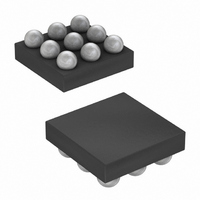MAX9890BEBL+T Maxim Integrated Products, MAX9890BEBL+T Datasheet - Page 8

MAX9890BEBL+T
Manufacturer Part Number
MAX9890BEBL+T
Description
IC SUPP CLICK-POP 9-UCSP
Manufacturer
Maxim Integrated Products
Type
Audio Suppressorr
Datasheet
1.MAX9890BETAT.pdf
(12 pages)
Specifications of MAX9890BEBL+T
Applications
Cell Phones, PDA's
Mounting Type
Surface Mount
Package / Case
9-UCSP®
Lead Free Status / RoHS Status
Lead free / RoHS Compliant
ness (on-resistance flatness is defined as the difference
between the maximum and minimum values of on-resis-
tance measured over the specific analog-signal range).
PSRR is the measurement of AC power-supply ripple or
noise that couples to the output. Variations in supply volt-
age corrupt the audio signal, due to changes in the R
value by supply modulation. The FFT shown in Figure 5
was taken with a 19kHz 1V
supply voltage, and a 20kHz 1V
IN_ with a 32Ω load is shown in Figure 6. The MAX9890
maintains a -100dB (typ) PSRR across the supply voltage
range eliminating any corruption of the audio signal from
supply variations. Therefore, with a zero audio signal, the
R
tribute to any output signal modulation.
In addition to the cost and size disadvantages of the
output-coupling capacitors, these capacitors limit the
amplifier’s low-frequency response and can distort the
audio signal.
Audio Click-Pop Suppressor
Figure 5. FFT for PSRR
8
ON
_______________________________________________________________________________________
variation due to supply voltage ripple does not con-
Power-Supply Rejection Ratio (PSRR)
-100
-110
-120
-130
-140
THD
-10
-20
-30
-40
-50
-60
-70
-80
-90
10
0
15
MAXIMUM
V
R
CC
L
= 32Ω, V
= 4.5V TO 5.5V, f
17
Low-Frequency Response
FREQUENCY (kHz)
IN
=
19
P-P
= 1V
R
4
FLAT ON
R
sine wave onto the 5V DC
P-P
LOAD
P-P
21
VCC
, f
(
IN
sine wave applied at
= 19kHz,
= 20kHz
)
23
×
100
25
%
ON
The impedance of a headphone or speaker load and
the output-coupling capacitor form a highpass filter with
the -3dB point set by:
where R
the output-coupling capacitor value. The highpass filter
is required by conventional single-ended, single power-
supply headphone drivers to block the midrail DC bias
component of the audio signal from the headphones.
The drawback to the filter is that it can attenuate low-
frequency signals. Larger values of C
effect but result in physically larger, more expensive
capacitors. Figure 7 shows the relationship between the
size of C
tion. Note that the -3dB point for a 16Ω headphone with
a 100µF blocking capacitor is 100Hz, well within the
normal audio band, resulting in low-frequency attenua-
tion of the reproduced signal.
The MAX9890A and MAX9890B have different turn-on
times to accommodate different size output-coupling
capacitors (see Table 1). Using a capacitor smaller
than the specified maximum allowed does not degrade
click-pop suppression. Therefore, capacitors less than
100µF can be used with the A or B version devices.
Figure 6. PSRR Test Circuit
V
V
19kHz
V
V
20kHz
L
DC
AC
DC
AC
OUT
= 1V
= 1V
= 5V
= 2.0V
is the headphone impedance and C
P-P
P-P
and the resulting low-frequency attenua-
f
−
3
IN_
IN_
dB
=
RAMP
UP
2π
R C
L OUT
1
V
CC
MAX9890
DOWN
RAMP
SHDN
OUT
OUT_
OUT_
reduce this
OUT
R
L
is












